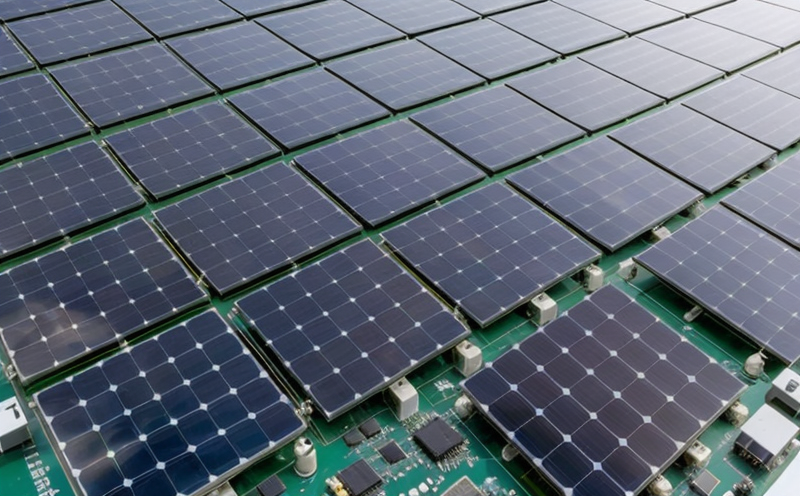ASTM E1036 Solar Irradiance Performance Testing
The ASTM E1036 standard provides a comprehensive framework for evaluating the performance of photovoltaic (PV) cells and modules under various solar irradiance conditions. This service is essential for ensuring that renewable energy electronics meet stringent quality, safety, and efficiency requirements.
ASTM E1036 is particularly relevant in today’s rapidly evolving solar technology landscape where manufacturers strive to optimize their products’ performance while adhering to strict international standards. The test aims at determining the maximum power output of PV cells or modules under specific simulated solar irradiance conditions, which are carefully controlled and standardized.
The testing process involves exposing specimens to a series of pre-determined irradiances and measuring their electrical outputs. This data is then used to assess how well the devices perform across different light intensities, simulating real-world conditions they might encounter throughout their operational life cycle. By adhering strictly to ASTM E1036 guidelines, manufacturers can verify that their products meet industry standards and are reliable under diverse environmental scenarios.
The significance of this testing cannot be overstated as it ensures that solar energy systems operate efficiently even when faced with variations in sunlight intensity due to time of day, seasonality, or geographical location. Such consistency is crucial for optimizing the performance of renewable energy installations worldwide.
At Eurolab, we employ state-of-the-art equipment and methodologies compliant with ASTM E1036 standards to conduct these tests accurately and reliably. Our experienced engineers ensure that every step from specimen preparation through final analysis adheres strictly to prescribed procedures outlined in this standard.
This service is particularly valuable for quality managers who need assurance about the robustness of their product designs; compliance officers seeking validation against regulatory requirements; R&D engineers looking to refine their prototype performance metrics; and procurement professionals interested in sourcing high-quality components from reputable suppliers. By leveraging our specialized expertise in ASTM E1036 testing, clients gain insights into their products’ actual field behavior before large-scale deployment.
To summarize, ASTM E1036 solar irradiance performance testing is a critical component of any comprehensive quality assurance program for renewable energy electronics. It helps stakeholders ensure that their devices function optimally under real-world conditions while maintaining safety and regulatory compliance.
Applied Standards
| Standard | Description |
|---|---|
| ASTM E1036-18a | This standard specifies the procedure for determining the maximum power output of photovoltaic cells or modules under defined solar irradiance conditions. |
| ISO 9806:2015 | International standard specifying requirements and methods for measuring spectral hemispherical irradiance, which is crucial in ASTM E1036 compliance. |
| IEC 60904-7:2016 | This part of the IEC 60904 series provides additional guidance on calibrating and operating solar simulators, ensuring accurate results in ASTM E1036 testing. |
| EN 50498-1:2017 | A European standard providing further detail on the measurement of spectral characteristics relevant to photovoltaic performance assessment under various irradiance levels. |
Scope and Methodology
The scope of ASTM E1036 solar irradiance performance testing encompasses a range of activities aimed at evaluating the maximum power output capability of photovoltaic cells or modules. The methodology involves several key steps:
Firstly, specimens are prepared according to specified dimensions and surface conditions required by the standard. These preparations ensure consistency across all test samples so that any observed differences can be attributed solely to variations in solar irradiance.
Secondly, the specimens are exposed to a series of pre-determined irradiances within the range typically encountered during operation. Typically, this includes typical air mass (TAM) conditions such as TAM1, TAM2, and TAM5, which correspond approximately to clear sky conditions at different times of day.
Thirdly, using high-precision instruments calibrated according to relevant international standards like ISO 9806 or IEC 60904, the electrical output is measured continuously throughout each exposure period. This continuous monitoring allows for precise determination of maximum power points under each set of irradiance conditions.
Finally, based on these measurements, detailed reports are generated that summarize both raw data and interpretative conclusions regarding how well the specimens performed across all tested irradiances. These reports serve as valuable references not only during development stages but also post-commercial release for troubleshooting purposes if necessary.
Eurolab Advantages
At Eurolab, our commitment to excellence in ASTM E1036 solar irradiance performance testing is reflected in several key advantages:
Accurate and Reliable Results: Our team of experts ensures that every test adheres meticulously to the strictest standards set forth by ASTM E1036. This guarantees accurate and reliable results that are trusted both locally and internationally.
State-of-the-Art Equipment: We utilize cutting-edge technology including advanced solar simulators calibrated against recognized international benchmarks such as ISO 9806 and IEC 60904-7. These tools enable precise control over irradiance levels, ensuring consistent and repeatable test conditions.
Detailed Reporting: Beyond just providing numerical outputs, our comprehensive reports offer in-depth analysis highlighting trends and insights into performance across different irradiances. This holistic approach helps clients make informed decisions about their product development processes or operational strategies.
Compliance Support: With thorough knowledge of regulatory requirements worldwide, Eurolab can assist you navigate complex compliance issues related to ASTM E1036 testing. Our consultants help ensure that your products comply with all necessary specifications, thereby reducing potential risks associated with non-conformance.





